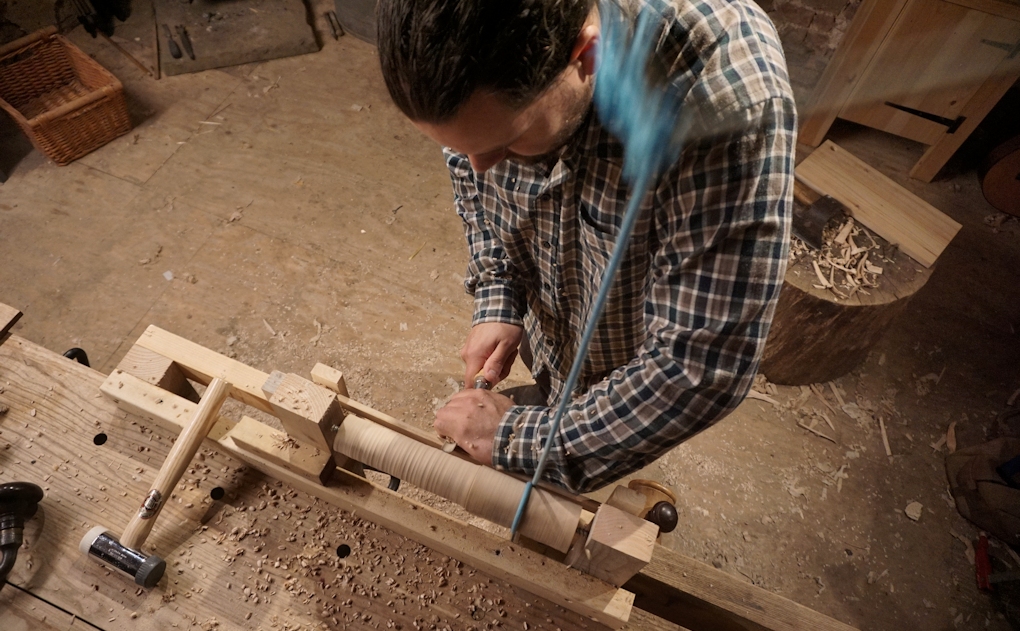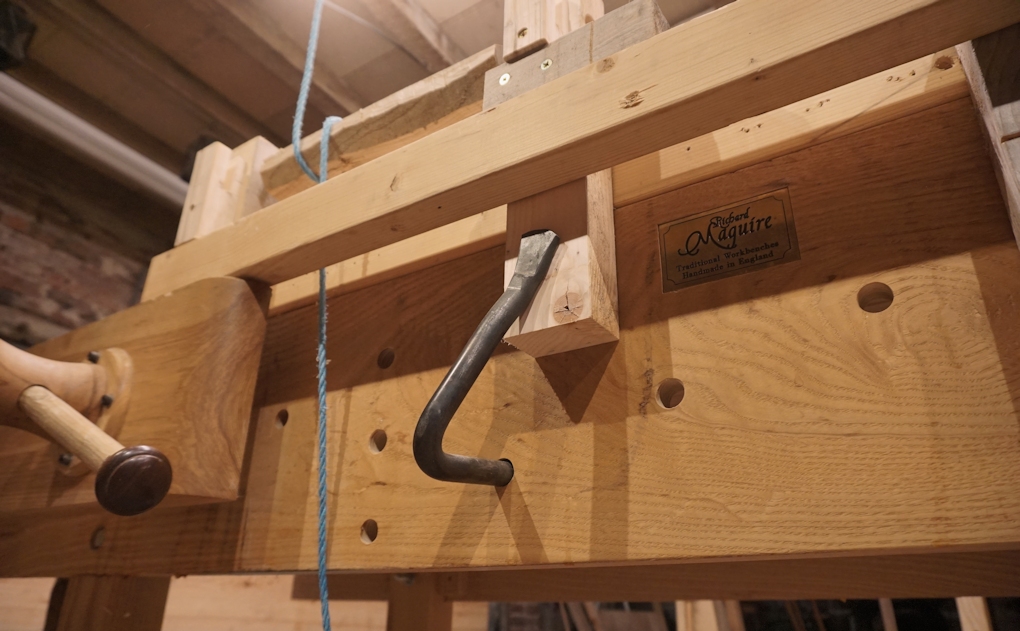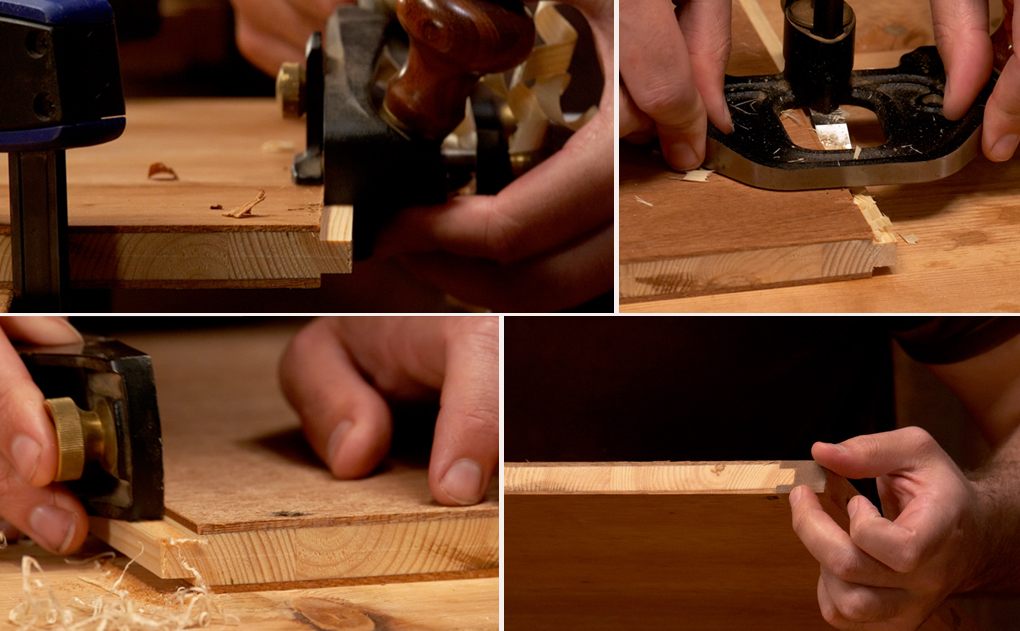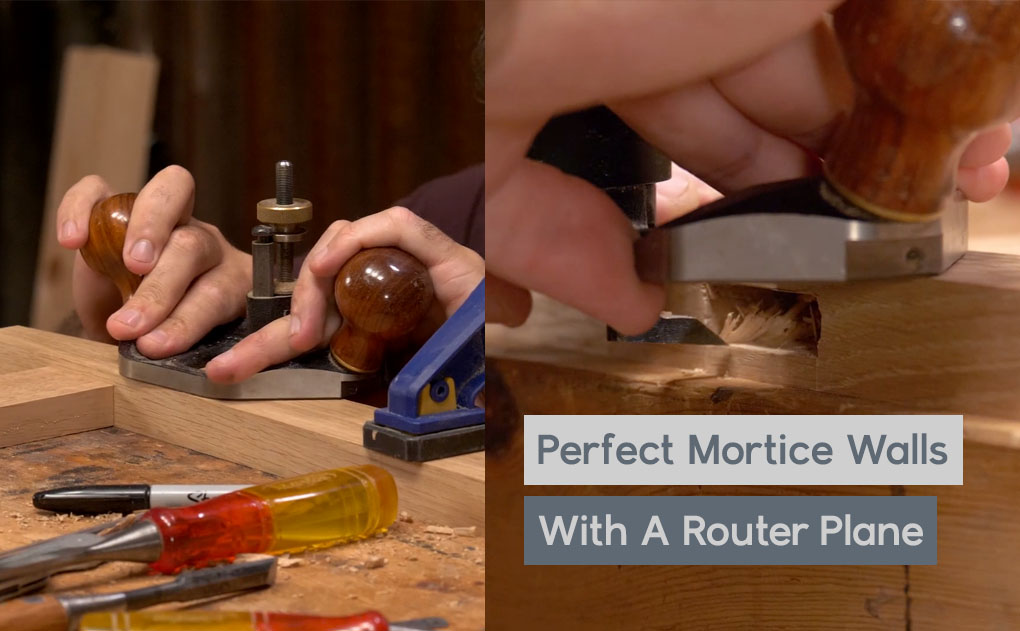 I recently knocked up a couple more commodes and have now turned my attention to the second of the Stooges – The Moravian Back Stool. I’m very fond of this design and whilst the commode was all square this one’s all angles and I’m starting out by tooling up.
I recently knocked up a couple more commodes and have now turned my attention to the second of the Stooges – The Moravian Back Stool. I’m very fond of this design and whilst the commode was all square this one’s all angles and I’m starting out by tooling up.


A lathe can be a useful tool for the hand tool workshop, but it isn’t something I’ve ever dedicated floor space to (except for one, but that was outside). However I have knocked up a few like this one. Like many things that I use in my furniture, I’ll knock it up quickly, complete the job and then it gradually makes it’s way to the firewood pile or gets refashioned in to something new.
Over the years the design has become fine tuned, at least from a quick and simple build point of view, although there’s no denying each one becomes less and less of a looker.
I’m pondering whether to come up with a more refined design or rather to just publish designs of this one and then leave it to you to refine if needed. I’m swaying to this option because I don’t need it to be anything more than it is.

 The most notable points are that it is bench mounted. This takes advantage of already having a very solid workbench and I can hold mine down through a combination of the face vice and a holdfast. The lathe itself isn’t all that robust but it works great since it is held so firmly by the bench.
The most notable points are that it is bench mounted. This takes advantage of already having a very solid workbench and I can hold mine down through a combination of the face vice and a holdfast. The lathe itself isn’t all that robust but it works great since it is held so firmly by the bench.
It’s foot and bungie powered, very simple to set up and remarkably effective. Unlike a small motor the power is unrestricted so you can give it some welly if you’re feeling up to it, it can take it because the workbench is such a strong and stable platform. I think my leg can create more torque than most bench top lathes, so don’t think that these things are slow.
It can be built in less than twenty minutes, I used some scrap building pine for this one and it’s fixed together with half a dozen Spaxs and the centres are nothing more than a couple of lag screws.
It’s compact to store, and whilst this one’s short you can build it as long as you’re bench if need be.
The reason I’ve always favored a bench top lathe is because I’ve had unstable workshop environments, often moving at the drop of a hat. Also, floor standing ones need a lot of support and bracing to prevent them wiggling around, and there’s nothing worse than a flimsy human driven lathe. A robust, compact floor standing model is possible but these require to be built more stout which isn’t something I’ve been able to give the time or effort.
 Whilst the chair itself won’t be requiring any turnings, we do need to make ourselves a reamer and a circumciser, so that’s the next job.
Whilst the chair itself won’t be requiring any turnings, we do need to make ourselves a reamer and a circumciser, so that’s the next job.
On a personal note I love the finish that human powered lathes can give, it tells a story much like a hand planed board. Electric powered lathes are a bit too planer/ thicknesser-ey for me
There’s a short video of this in action over on our Facebook page.

![Which Saws Are Best For Ripping Thick Stuff? [Video]](https://www.theenglishwoodworker.com/wp-content/uploads/2022/12/what-hand-saw-is-best-for-thick-rip-cuts.jpg)

![Quick Homemade Clamps – Small & Large [with video]](https://www.theenglishwoodworker.com/wp-content/uploads/2022/08/how-to-make-your-own-woodworking-clamps.jpg)

Refined or not, the design would be nice. Thanks
First a more enlightening video, but then, and definitely, a plan.
Publish it as it is! I omit any window dressing present in plans for utility stuff anyway. I have a powered lathe but would love to experiment with something like this
Simple is always the best. I think this is just about the simplest lathe I have ever seen used.
Where is the bungie? Is the blue rope a rigid cord (not very stretchy) and it ties to a loop of bungie at the ceiling? Could you post a photo of the top of the blue cord and the bungie cord?
Do you think this could work in a low 7-foot ceiling or do you need a long bungie?
Hi Ed, yes it will work with a low ceiling, that’s why I like this system. I’ve just posted a quick video for you on Facebook to show this better.
The blue cord is strong and rigid as you say and that’s just tied to a bungee strap secured to the ceiling.
Thanks for posting the bungie. Now I get it- It takes force on the cutting stroke, which can be as strong as you like via your foot, but it takes relatively little force to pull the treadle back up, so you don’t need anything fancy up above. As for not being something exciting to watch with tea, I’ll watch just about anything as an excuse for tea.
Richard, Think there’s enough detail in the photos to make one – and there I was thinking I had a free afternoon!!
Thank You!
When does a woodworker ever have a free afternoon!
Richard,
this is a beautifull idea. I never thought about using a benchtop pole lathe.
What are you using for a bungee?
Thanks
Frederik
Cheers Frederik,
it’s just a bungee strap tie, about half a metre long with two hooks on the ends. Normally found next to the ratchet straps if you’re in a shop.
Circumsizer? please explain briefly (no pun)
Hi Paul, It’s a round tapered tenon cutter to go alongside the reamer.
The lathe is brilliant but the circumciser sounds a bit worrying………..
Sorry Paul, that’s because it is… 😉
I love this! I need to make one.
Thanks for posting this. I’ve wanted to try lathe work for a while but a proper lathe would get too little work to make sense building, Jennie Alexander has a neat design for a benchtop lathe on her website but it uses a tail vise. This is a very simple design that seems like it could be easily adapted to my bench. I’ll have to give it a try.
Thanks Graham,
my reasonings for this lathe are pretty similar to yours, I just don’t have the need or excuse for a fully fledged big thing. I’ll have a little look for Jennie’s lathe, her chairs are some of the most beautiful I’ve ever seen.
Please please please publish the plans. This is exactly what I need for my shop! Perfect. And I know if it’s your design it’ll be simple but effective. Please!
Don’t worry John, should be here early next week.
Wow thanks Richard. A star you are!
Excellent! Many thanks in advance Richard, I’m full of excitement. A foot powered lathe has been on my to-do list for ages, ever since I tried one at a show once. They used a large portable frame, which I would never have the space for, one that fits in the vice is brilliant!
What a brilliant idea. I’ve often wished I could turn the occasional small part but the cost of a lathe and all the associated bits and bobs has always put me off. This is exactly the sort of thing that’ll allow me to progress without breaking the bank. Thanks for sharing this – I can’t wait for the published plans.
I agree with Jon. Brilliant, simple and neat. Can’t think why I never thought of trying it – thank you Richard for showing us.
Guess I’ll have a lathe in short order. The bungee is genius, Richard.
Nothing to add but Thank You! Can’t wait to see the plans.
Richard, your stuff is always high on my list as soon as you publish and this yet again doesn’t disappoint.
But how high are your ceilings? I notice on the Facebook video you have it between joists which is handy to keep the bungee from slapping into the ceiling. I see someone in the comments asking about the height issue but I wonder about this in even a typical 8′ ceiling room.
For example if I were to construct this in my shop I would need to add a couple boards to the sheetrock up there since I don’t have open joists. This would drop the bungee down to about 7′ or under since I have 7.5′ ceilings in my shop. Even if at rest the treadle touches the underside of the lathe giving me an ~3′ stroke which should be sufficient for 3-5 rotations of the spindle, the bungee is also going to deflect a similar amount and bring it down below my chin or potentially on top of my head or at worst to the spindle itself. Certainly it will fall well within my eye line and I would think that would get pretty distracting.
I’ll have to give this a try just to experiment. I do love the idea of a solid foundation by using the bench. Not that I need another foot powered lath in my shop.
Thanks Shannon,
Good to hear from you. I’ve just measured our ceiling over the bench area where this is set up and it’s actually bang on 7′ (it makes it a right arse to film!). As a quick test I think I’m getting around 3 revolutions per stroke. I suppose you could set the bungee back from the lathe to emulate height? I’ll experiment and I’ll be writing a bit more on this in the next post.
I highly doubt you’ll need another lathe, I’m a bit green already of the one’s you’ve got!
If I relied on need when it comes to lathes, I would have stopped building them about 4 lathes ago! If nothing else, your post got me out in the sunshine of the yard to play with my own bungee lathe.
This seems like a great way to start turning. I have been turning-curious for a long time, but both money, and even more so space, is at a premium for me. This solves both problems.
I know your post is five years old at this point, but I’m wondering if you modified the lag screws in any way. I’d always read that a lathe’s centers need to be perfectly conical, so I’m wondering if you filed down the screws at all. Thanks and great design.